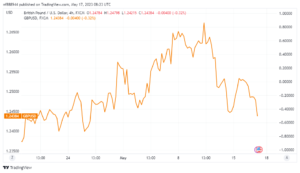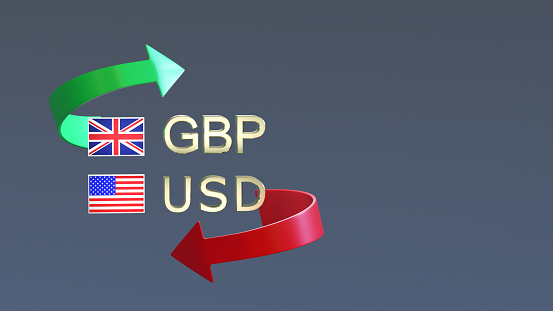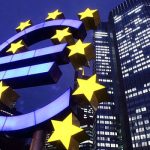On Tuesday, the GBPUSD pair saw excellent two-way price swings. Before eventually settling in the red, undoing a large portion of the previous day’s bullish rise. Spot prices regained roughly 80 pips intraday. But were unable to capitalize on the advance and were confronted with new supply near the 1.2545 zone.
Speculations of fewer rate rises by the Bank of England undercut the GBP and weigh on a modestly positive USD.
The British Pound remains under pressure as a result of the fairly underwhelming UK monthly employment figures. Which have spurred speculation that the Bank of England (BoE) may need to raise interest rates less often. In the coming months to keep inflation under control. The UK Office for National Statistics (ONS) revealed that the number of persons claiming unemployment-related benefits increased by 46.7K in April. Up from 26.5K in March and much above predictions for a reduction of 5%. 10.8 K.
Furthermore, the unemployment rate rose to 3.9% from 3.8%. Indicating that Britain’s labor market has begun to suffer as a result of the country’s slowing economy. According to the report’s further information. UK average earnings excluding bonuses climbed by 6.7%. In the three months to March, somewhat less than the 6.8% projected but slightly higher than February’s 6.6%.
In response to hawkish statements by Cleveland Fed President Loretta Mester. Which was regarded as another factor weighing on the GBPUSD pair. The US Dollar (USD) recovered upward traction and soared back to a five-week high. Mester stated that interest rates are not restrictive enough. And that the central bank is not yet in a position to hold rates. This resulted in a dramatic decrease. US Treasury bond rates rose overnight.
The fundamental environment encourages bearish traders and promotes the possibility of more losses.
Furthermore, the risk-off impulse bolstered the Greenback’s relative safe-haven reputation against its British equivalent. As seen by a generally lower tone in the equities markets. Softer Chinese macro data reported on Tuesday indicated a shaky post-COVID recovery in the world’s second-largest economy. Fueling recession worries. This follows an impasse on raising the federal government’s borrowing ceiling. And it dampens investors’ desire for risky assets. Meanwhile, the USD bulls were unmoved by mixed US Retail Sales data. Which did nothing to temper market expectations that the Fed will maintain its hawkish attitude and keep rates higher for longer.
Nonetheless, the GBPUSD pair concluded the day with minor losses and stayed in the red. During the Asian session on Wednesday, the market was on the defensive. In the absence of any market-moving economic data from the UK, the market’s attention will be drawn to BoE Governor Andrew Bailey’s address at the British Chambers of Commerce Global Annual Conference in London. Traders will take cues from the US home market statistics – Building Permits and Building Permits – later in the early North American session. Aside from that, US bond rates and wider risk sentiment will fuel USD demand, which should aid traders in capturing short-term chances around the major.
GBPUSD Technical Outlook
Technically, the overnight failure near the 100-period Simple Moving Average (SMA) on the 4-hour chart lends validity to the recent fall through the lower end of overbought territory. an upward trend channel that has been in place for one month.
The ensuing decline and acceptance below the psychological level of 1.2500 suggests that the GBPUSD pair’s path of least resistance is to the downside.

Some follow-through selling below the weekly low, around the 1.2445 region, will confirm the bearish bias and lay the way for an extension of the current rapid drop from a one-year high, around the 1.2680 level, reached last week. Spot prices might go below 1.2400 and test the next key support between 1.2375-1.2370.
Attempts to recover above the 1.2500 level, on the other hand, may face severe resistance near the previous day’s swing high, in the 1.2545 range. A prolonged rise above that level might spark a short-covering rally, allowing the GBP/USD pair to rise. Reclaim the 1.2600 level. The momentum may extend into the 1.2625-1.2630 intermediate obstacle way to the YTD top, which is expected to be around the 1.2680 range.









